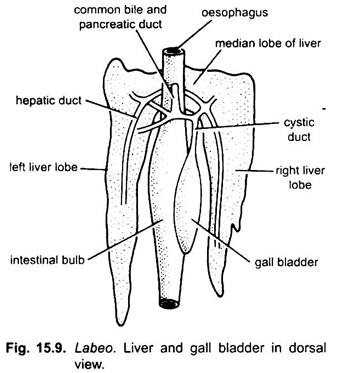Digestive system includes the alimentary canal and the associated digestive glands.
Alimentary Canal:
The alimentary canal is a long tube comprising mouth, buccal cavity, pharynx, oesophagus, stomach, intestine and rectum.
1. Mouth:
The mouth is a sub-terminal crescentic slit bounded by fleshy upper and lower lips. These lips bear four or five rows of conical papillae.
ADVERTISEMENTS:
2. Buccal Cavity:
The mouth leads into a broad, dorso-ventrally compressed buccal cavity. The mucous membrane lining the buccal cavity bears minute papillae. In Labeo teeth and tongue are not present. The floor of the buccal cavity is provided with thick muscles.
3. Pharynx:
The buccal cavity leads into a dorsoventrally compressed pharynx. The pharynx is laterally bounded by gill-arches and is well differentiated into a broad anterior respiratory part and a narrow posterior masticatory part. The anterior respiratory part is perforated laterally by 4 pairs of gill-slits. From gill-arches project into pharyngeal cavity small spiny gill-rakers which prevent the passage of food through gill-slits.
ADVERTISEMENTS:
The posterior masticatory part of pharynx bears closely set 3 rows of homodont pharyngeal teeth on its ventro-lateral walls for masticating the food. Each tooth has a narrow basal root and a conical crown. The floor of this part is highly folded transversely.
4. Oesophagus:
The pharynx leads into a short, narrow, tubular oesophagus. Its mucosal lining is longitudinally folded. The pneumatic duct (ductus pneumaticus) from the air bladder opens dorsally into the oesophagus.
5. Stomach/Intestine:
ADVERTISEMENTS:
In Labeo, true stomach is absent. The oesophagus opens into a swollen sac-like anterior part of intestine. This sac-like part is called intestinal bulb in which food is stored. The oesophageal opening into the intestinal bulb is guarded by an oesophageal valve to prevent regurgitation of digested food. Gastric glands are lacking in intestinal bulb. The mucosa of the intestinal bulb contains absorptive and mucous cells.
The intestinal bulb is also differentiated into an anterior broader cardiac part into which open the pancreatic and bile ducts, and a posterior narrow pyloric part. Pyloric caeca are absent. The mucosa of cardiac part form honey-comb-like folds and that of pyloric part forms longitudinal folds.
Intestinal bulb is followed by a thin-walled, narrow, elongated and convoluted intestine. Its mucosa forms oblique transverse folds in the anterior region and longitudinal folds in the posterior region. Since Labeo is a herbivorous fish, its intestine is longer in comparison of carnivorous fishes. Intestinal villi and scroll valve are absent in Labeo.
6. Rectum:
The intestine is followed terminally into a thin-walled, slightly dilated rectum. Its mucosal lining shows distinct oblique transverse folds. The rectum opens outside through anus located just in front of the urinogenital opening.
Digestive Glands:
Digestive glands of Labeo are liver and pancreas.
1. Liver:
It is a large, dark brown bilobed gland. Right liver lobe is narrower than that of left liver lobe. Both the lobes are interconnected at three regions, viz., anterior, median and posterior, by median connecting lobes. Gall bladder is an elongated sac of about 8 cm long and 2.5 cm in diameter, and is placed between the two liver lobes. A cystic duct arises from the anterior end of the gall bladder and receives three hepatic ducts from the liver lobes and then open into the cardiac part of the intestinal bulb.
ADVERTISEMENTS:
2. Pancreas:
It is a diffused structure found among the coils of intestine and also extends into the liver. Its exocrine part formed of acini is also found in spleen tissue in rohu, mrigal and catla fishes. Pancreatic duct opens separately into the cardiac part of intestinal bulb.
Digestion:
The mechanism of digestion is not clear. Intestinal mucosa secretes trypsin, erepsin and enterokinase. Pancreas secretes amylase. Pepsin and HCl are absent since stomach is lacking in Labeo.

